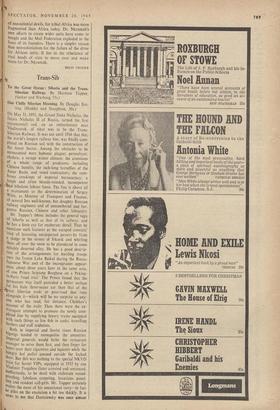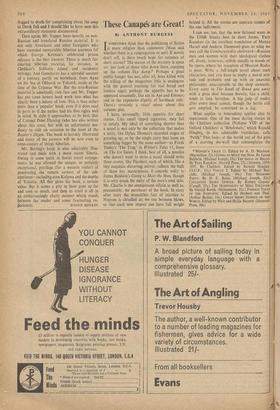Trans-Sib
t, the Great Ocean : Siberia and the Trans- Siberian Railway. By Harmon Tupper. (Seeker and Warburg, 55s.)
ON May 31, 1891, the Grand Duke Nicholas, the future Nicholas H of Russia, turned the first (ceremonial) sod, on an embankment near Vladivostok, of what was to be the Trans- Siberian Railway. It was not until 1916 that this, the world's longest railway line, was finally com- pleted on Russian soil with the construction of the Amur Sector. Among the obstacles to be surmounted were bubonic plague; permafrost; cholera; a savage winter climate; the attentions of a whole range of predators, including Chinese bandits, the inch-long horseflies of the Amur Basin, and venal contractors; the cum- brous creakings of imperial bureaucracy; a tough and often bloody-minded, incompetent l'And bibulous labour force. The line is above all a monument to the determination of Sergey Witte, as Minister of Transport and Finance, of several less well-known, but doughty Russian railway engineers and of unnumbered and for- gotten Russian, Chinese and other labourers.
Mr. Tupper's theme includes the general saga of Sibeila as well as that of its railway, and he has a keen eye for exuberant detail. Thus he Mentions such features as the escaped convicts' trick of lassooing unsuspected passers-by from a sledge in the streets of Irkutsk and whirling them off over the snow to be plundered in some suitably deserted alley. He has a good descrip- tion of the arrangements for hustling troops over the frozen Lake Baikal during the Russo- Japanese War and of the incongruous appear- ance, about three years later in the same area, of one Prince Scipione Borghese on a Peking- to-Paris 'road trial.' The Prince found, that the Permanent way itself provided a better surface for his Itala three-seater car than that of the 'treat Siberian trakt or post-road that runs alongside it—which will be no surprise to any- one who has read, for instance, Chekhov's account of the trakt. Then there were the ex- travagant attempts to promote the newly com- pleted .line by supplying luxury trains equipped With such things as live fish in tanks, travelling barbers and staff midwives.
Both in imperial and Soviet times Russian bigwigs tended to monopolise the amenities. Imperial generals would bribe the restaurant Manager to serve them first, and then linger for hours over their cigarettes and liqueurs while the hungry hoi polloi queued outside the locked
door. But this was nothing to the special NKVD train for Soviet VIPs, equipped in 1933 by one Vladimir Tregubov (later arrested and sentenced,
Ineffectually, to be shot) with elaborate sound- proofing, fabulous carpeting, luxurious panel- ling and resident call-girls. Mr. Tupper certainly Makes the most of his sensational story—in fact he piles on the exoticism a bit too thickly. It is news to me that Dostoievsky was once almost
flogged to death for complaining about the soup in Omsk Jail and I should like to have seen this extraordinary statement documented.
Then again, Mr. Tupper leans heavily on non- Russian and translated Russian material. It is not only Americans and other foreigners who have recorded memorable Siberian journeys (of which George Kennan's celebrated prison odyssey is the best known). There is much fas- cinating Siberian material, for instance, in Ohekhov's Sakhalin Island and incidental writings. And Goncharov has a splendid account of a journey, partly on horseback, from Ayan on the Sea of Okhotsk to Yakutsk, made at the time of the Crimean War. But the non-Russian material is admittedly rich fare and Mr. Tupper has put some honest hard work into what has clearly been a labour of love. This is thus rather more than a `popular' book, even if it does read in parts as if the author had his film rights well in mind. In style it approaches, at its best, that of Colonel Peter Fleming (who has also written about this area), but with an unfortunate ten- dency to sink on occasion to the level of the Reader's Digest. The book is lavishly illustrated and many of the pictures will be new even to connoisseurs of things Siberian.
Mr. Botting's book is also admirably illus- trated and deals with a more recent Siberia. Owing to some quirk in Soviet travel arrange- ments he was allowed the unique, or certainly exceptional, privilege (for a western visitor) of penetrating the remote corners of the sub- continent—including even Kolyma and the depths of Yakutia. All this gives his book a certain value. But it seems a pity to have gone so far and seen so much, and then to retail it all in an embarrassingly chatty manner which stands between the reader and some fascinating ex-



















































 Previous page
Previous page